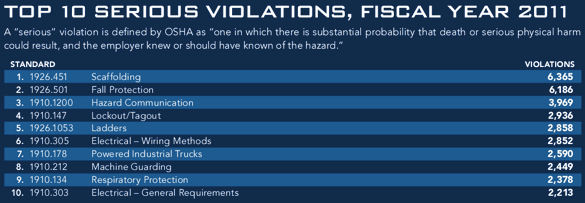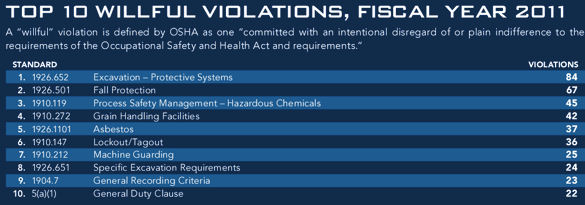OSHA's Top 10 most cited violations
OSHA’s Top 10 list of violations for FY 2011 offers employers additional means to improve occupational safety
By Kyle W. Morrison, senior associate editor
Year after year, the list of the 10 most frequently cited OSHA violations remains essentially the same. Some standards may swap positions, or a particular standard may creep up the list, but the basic layout goes unchanged.
But this does not imply OSHA is not doing its job, or that businesses are not learning how to avoid these hazards. In an interview with Safety+Health, Patrick Kapust, OSHA’s deputy director of the Directorate of Enforcement Programs, said the data found in the Top 10 list is not meant to gauge how well OSHA is performing or how safe businesses in the country are. This list is at its best when used by employers as a tool to improve safety at their worksites, he said.
“An employer who may be interested in what are the possible hazards in their workplace could look at the [Top 10] list and see if they’re covering all hazards and assessing the kind of changes they may have to make to their safety and health program,” Kapust told Safety+Health.
Kapust urged employers to look specifically at the subsections of the standards and use other tools at their disposal to create a safer workplace, including contacting OSHA assistance programs or downloading compliance materials from the OSHA website.
“If they have questions, we want employers to ask us so we can get the information out,” he said.
The following data is OSHA’s Top 10 list of the most frequently cited violations for fiscal year 2011, covering the period of Oct. 1, 2010, through Sept. 30, 2011.
EDITOR’S NOTE: The following data does not reflect all violations cited by OSHA during fiscal year 2011. OSHA currently is in a transition period in implementing its new OSHA Information System from its current Integrated Management Information System. This article only contains data from IMIS.












Post a comment to this article
Safety+Health welcomes comments that promote respectful dialogue. Please stay on topic. Comments that contain personal attacks, profanity or abusive language – or those aggressively promoting products or services – will be removed. We reserve the right to determine which comments violate our comment policy. (Anonymous comments are welcome; merely skip the “name” field in the comment box. An email address is required but will not be included with your comment.)

